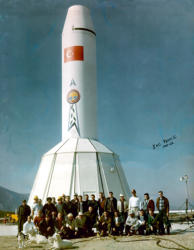
HISTORY - Page 65
Missile Testing Program
One of the more amazing factors in the JUPITER development program was the small amount of time that
elapsed between program approval and the actual flight testing of a missile that resembled the final
tactical configuration—November 1955 until March 1957. By comparison, the time frame was even more
compressed than the REDSTONE program—July 1950 to August 1953—but this system was the key to the
JUPITER success story. In many respects, JUPITER components were product improvements of REDSTONE
counterparts.
During the previously-mentioned missile study years of 1954 and 1955, the Redstone Arsenal group had
made wind tunnel tests of model missiles of every conceivable shape and form. Added to this, they had
the flight analysis of the REDSTONES. So when the JUPITER requirement came along, they knew what
configurations would fly. Even the forced reduction in length had no ill effects on the flight behavior
pattern. Components within the shell followed the same "building block" formula. For example, the angle-
of-attack indicator program dated back to 1952, and experience in this work was important in view of the
lack of control of the re-entry body. Speaking of the nose cone, even this configuration was solved within
six months of program inception, and the protective means by way of ablation was solved in nine months.
Practically every part of the missile had undergone an exhaustive testing program; and, thus, the JUPITER
development phase was a refinement to meet the IRBM requirements
88
. As a result, the JUPITER could have
been fired in anger in 1958, and possibly in 1957—two years, more or less, after program approval.
_____________________________







88. Fact Book, subj: JUP Test Results, Tab A, 22 Sep 57, Hist Off files.



Jupiter SM-78 Weapon System
I&C Team 2, Çigli AB, Turkey 1961-1962 Chrysler Corporation Missile Division

HISTORY - Page 65
Missile Testing Program
One of the more amazing factors in the JUPITER
development program was the small amount of time
that elapsed between program approval and the
actual flight testing of a missile that resembled the
final tactical configuration—November 1955 until
March 1957. By comparison, the time frame was even
more compressed than the REDSTONE program—July
1950 to August 1953—but this system was the key to
the JUPITER success story. In many respects, JUPITER
components were product improvements of REDSTONE
counterparts.
During the previously-mentioned missile study years
of 1954 and 1955, the Redstone Arsenal group had
made wind tunnel tests of model missiles of every
conceivable shape and form. Added to this, they had
the flight analysis of the REDSTONES. So when the
JUPITER requirement came along, they knew what
configurations would fly. Even the forced reduction in
length had no ill effects on the flight behavior pattern.
Components within the shell followed the same
"building block" formula. For example, the angle-of-
attack indicator program dated back to 1952, and
experience in this work was important in view of the
lack of control of the re-entry body. Speaking of the
nose cone, even this configuration was solved within
six months of program inception, and the protective
means by way of ablation was solved in nine months.
Practically every part of the missile had undergone an
exhaustive testing program; and, thus, the JUPITER
development phase was a refinement to meet the
IRBM requirements
88
. As a result, the JUPITER could
have been fired in anger in 1958, and possibly in
1957—two years, more or less, after program approval.
_____________________________
88. Fact Book, subj: JUP Test Results, Tab A, 22 Sep 57, Hist Off files.





















